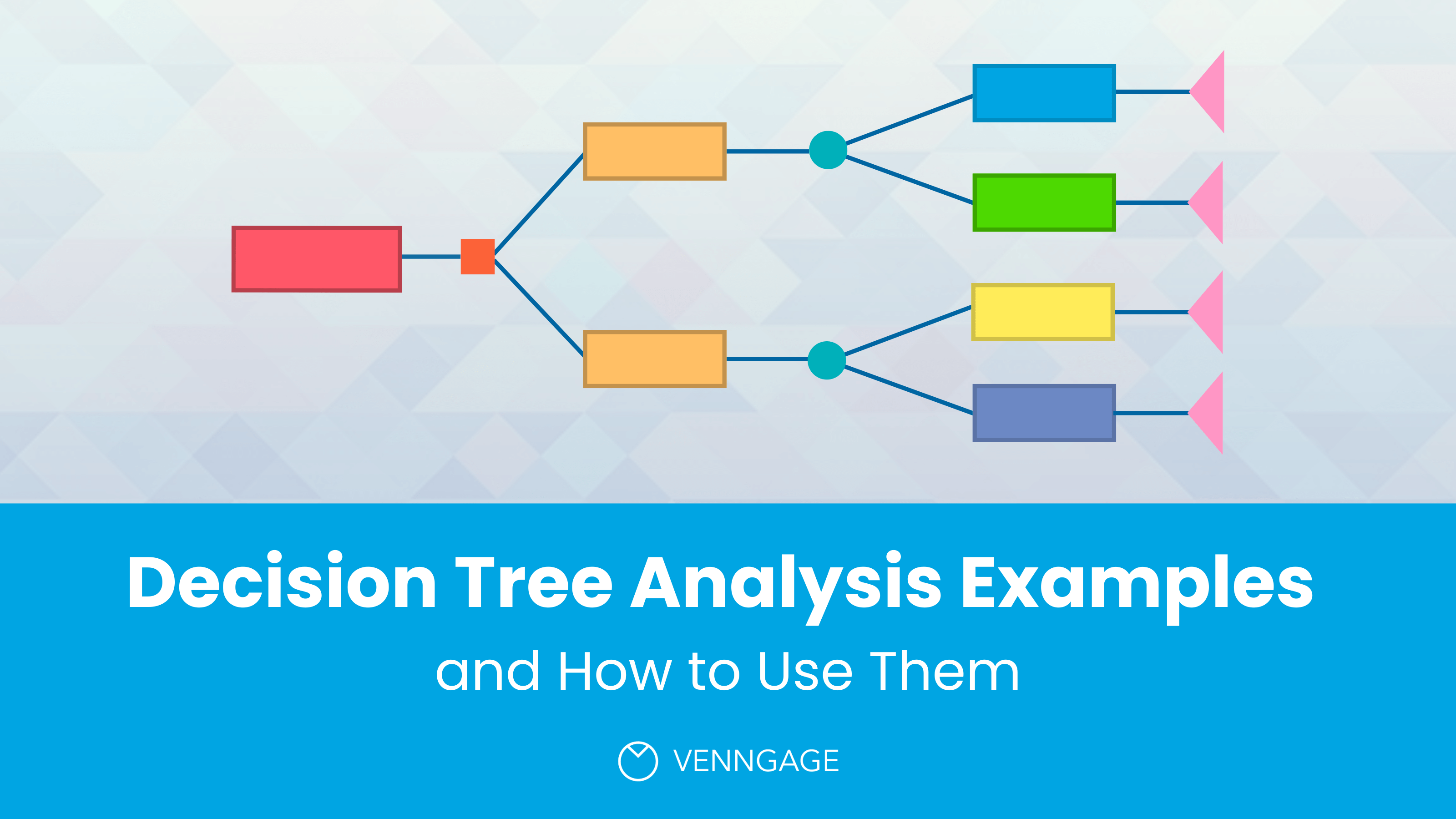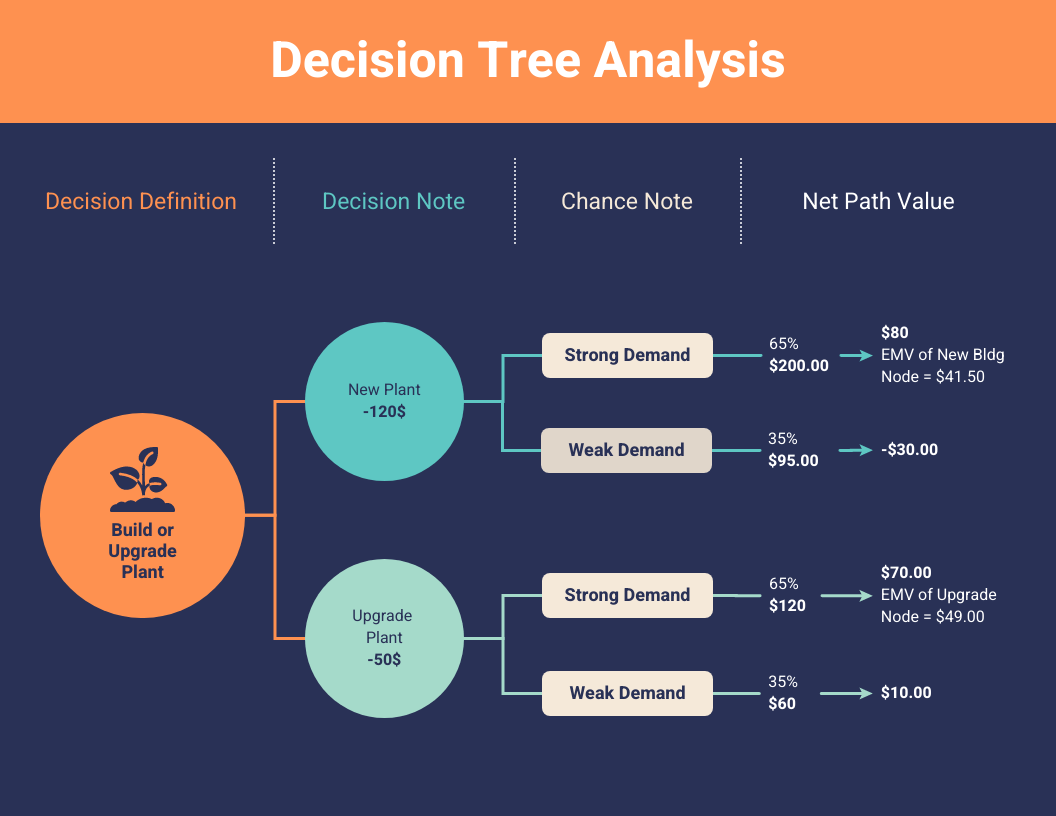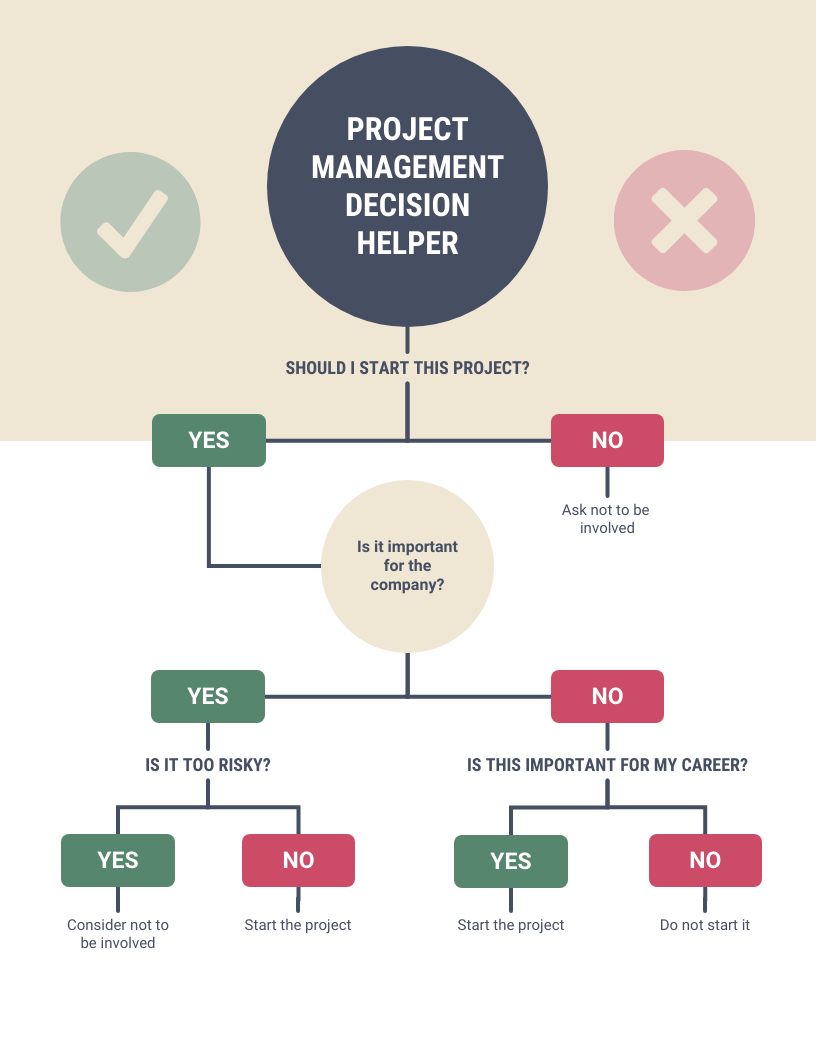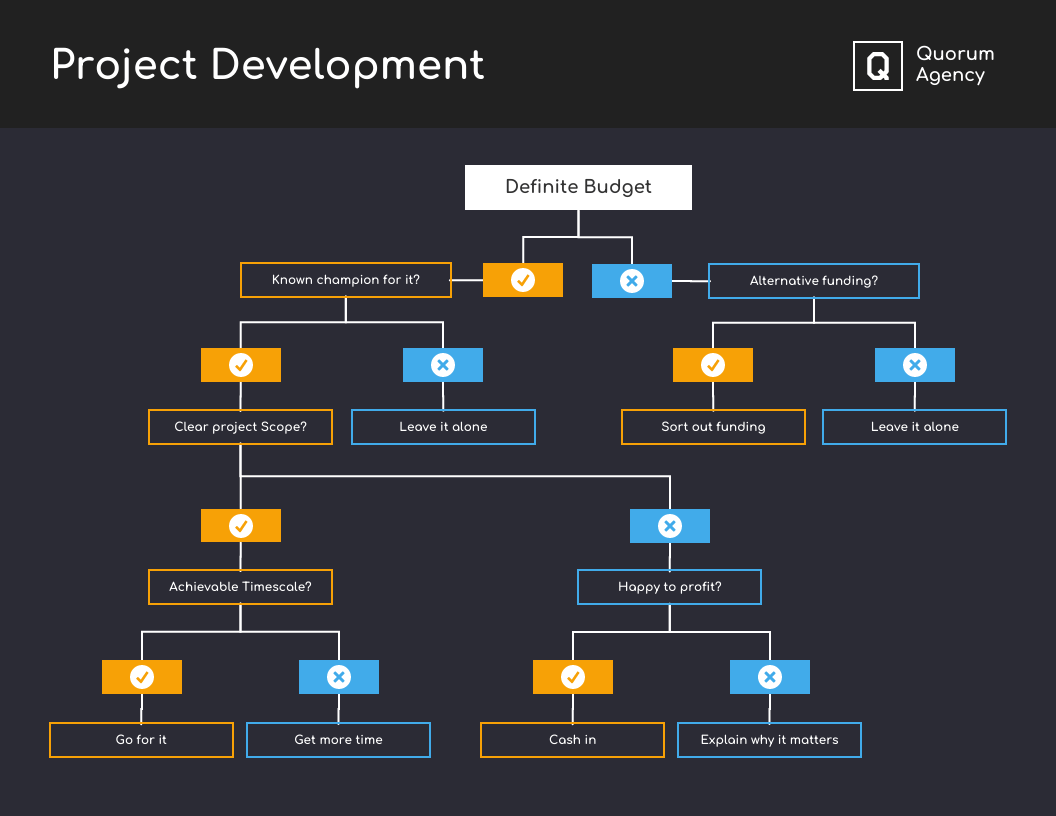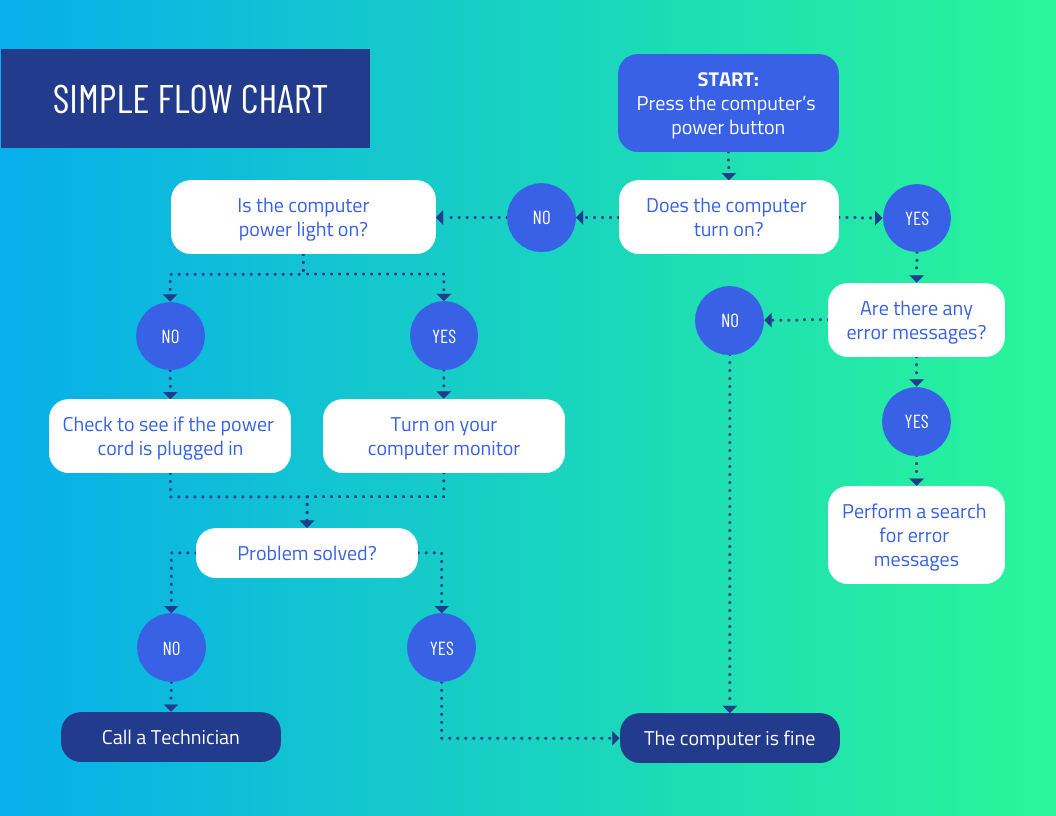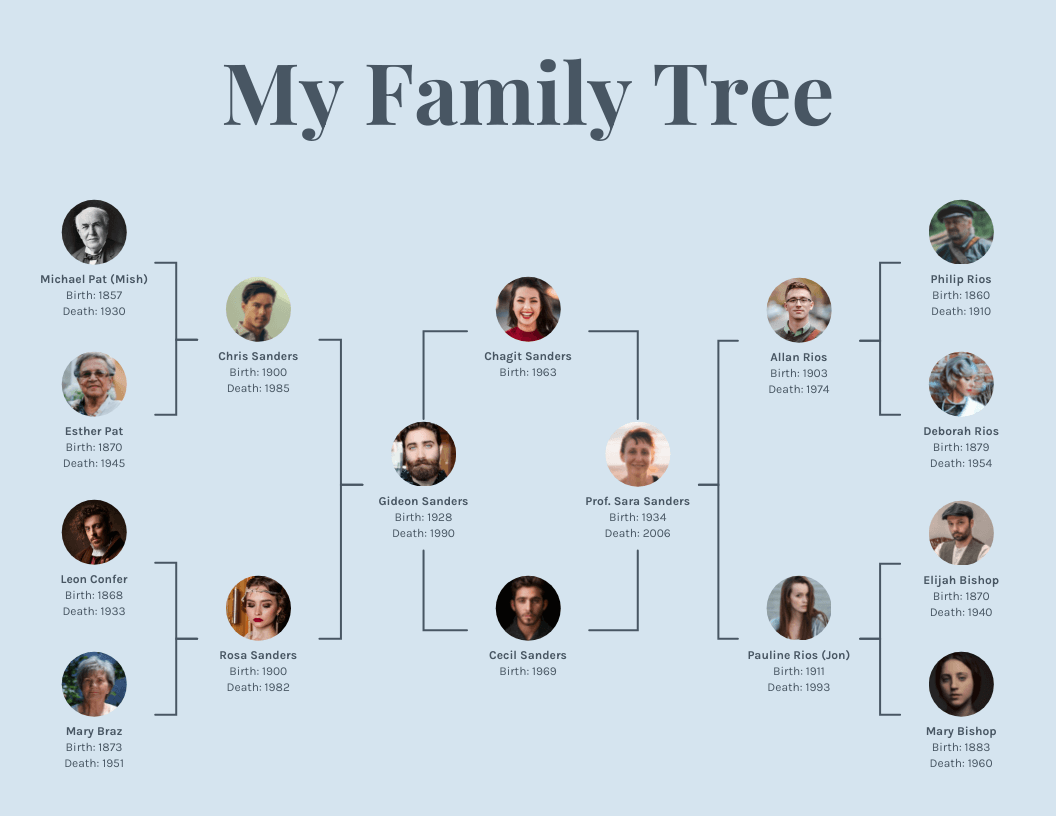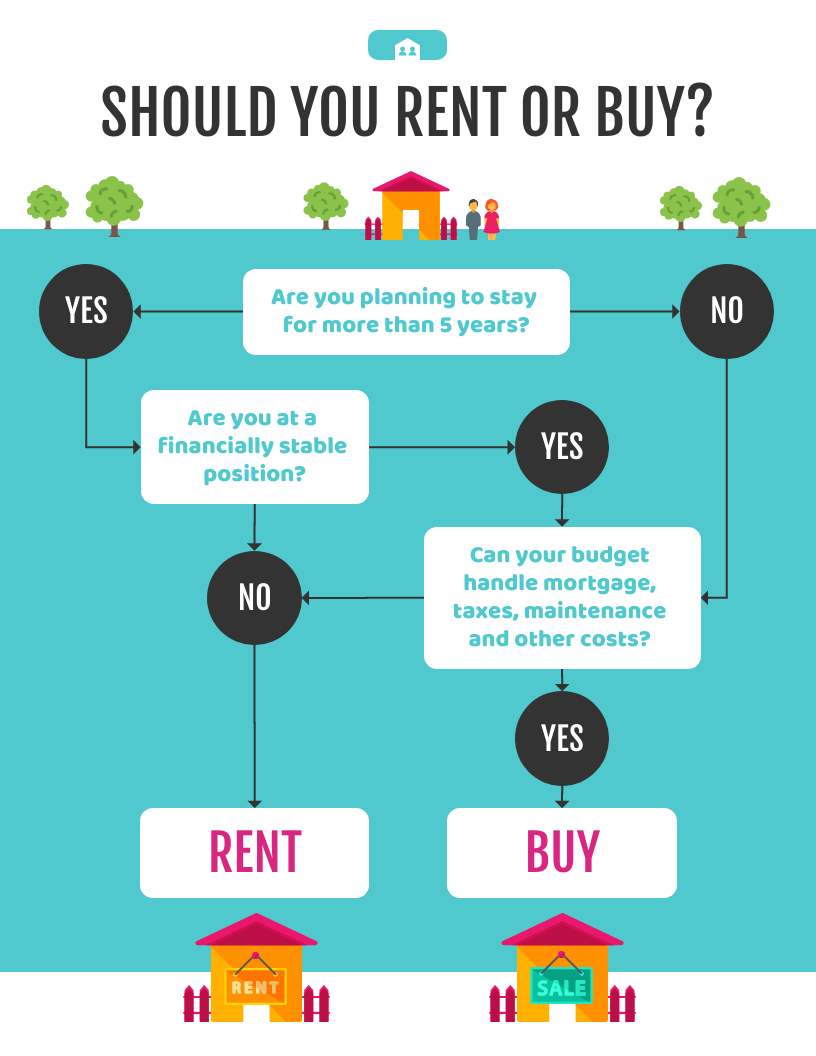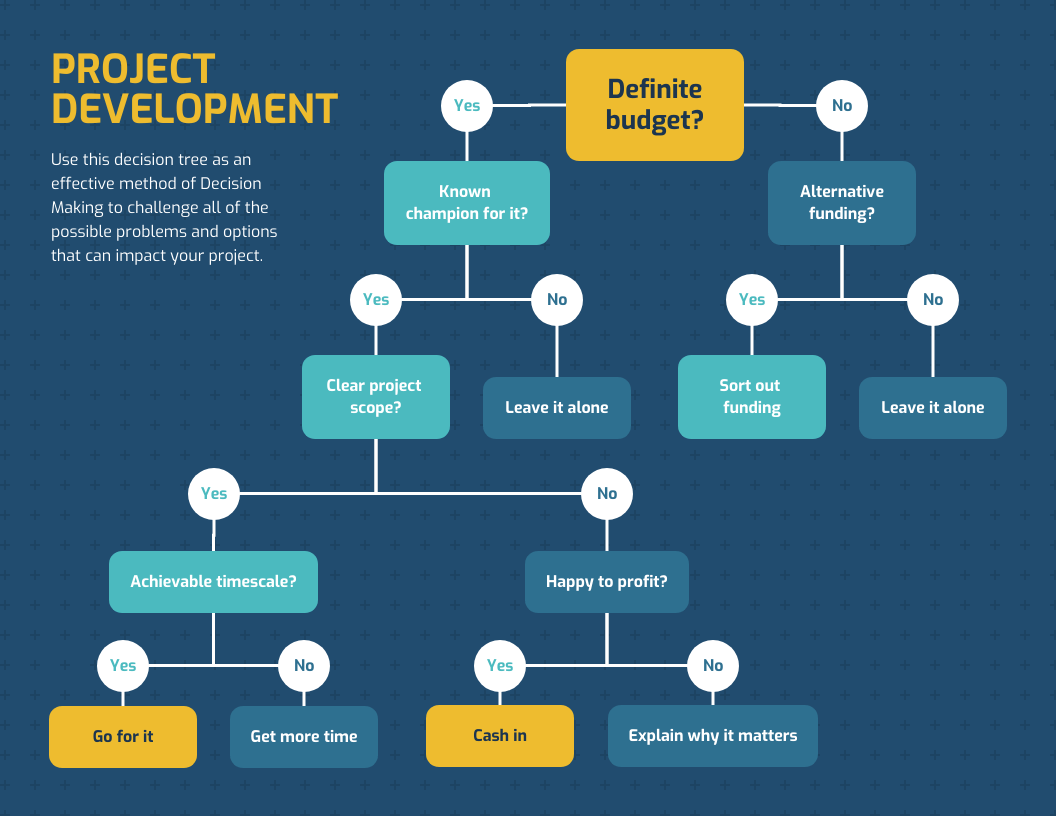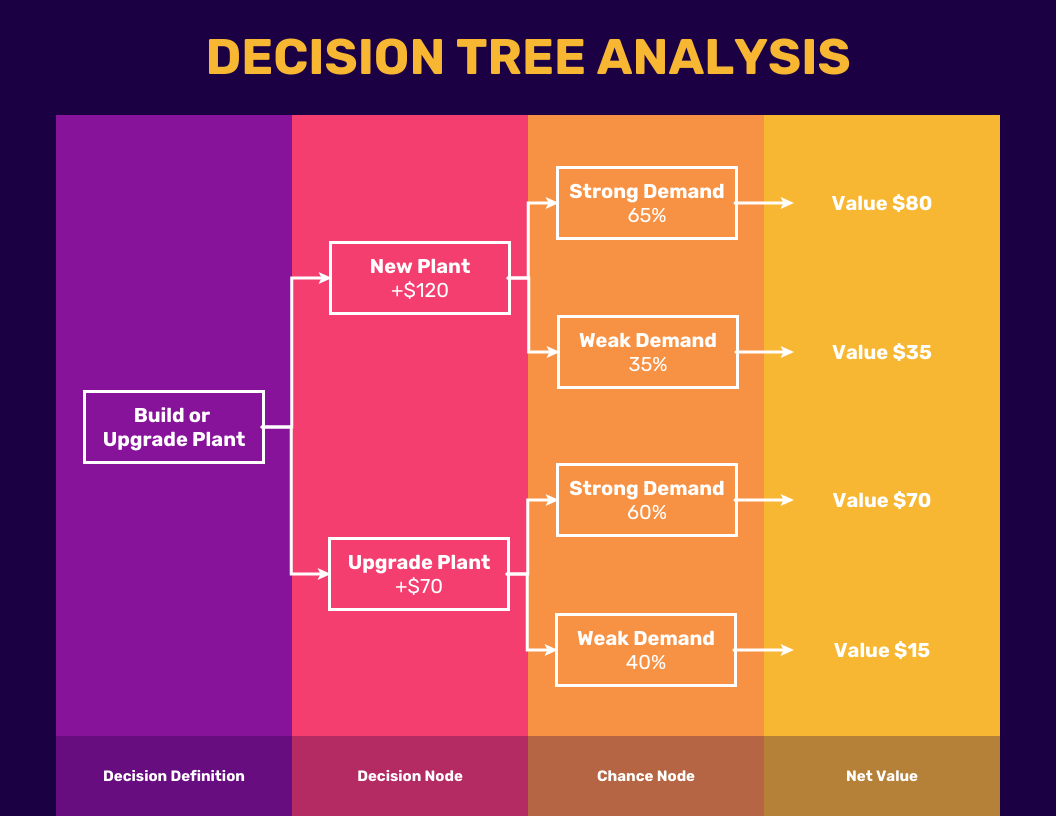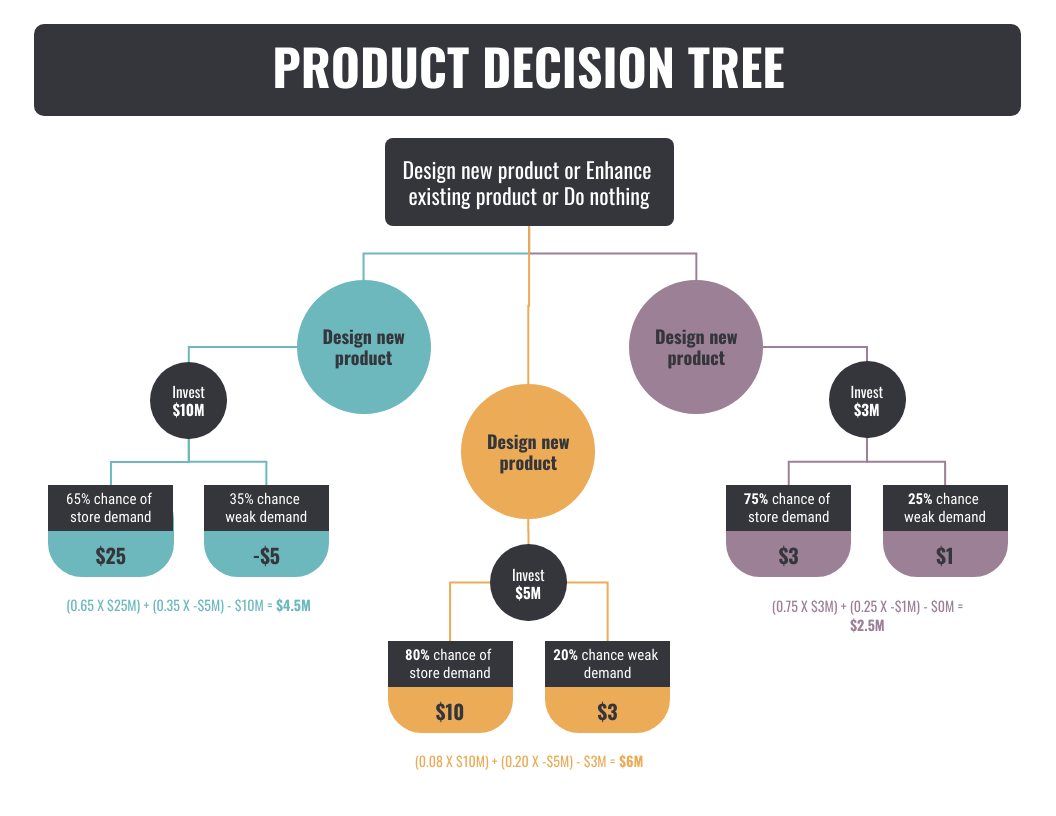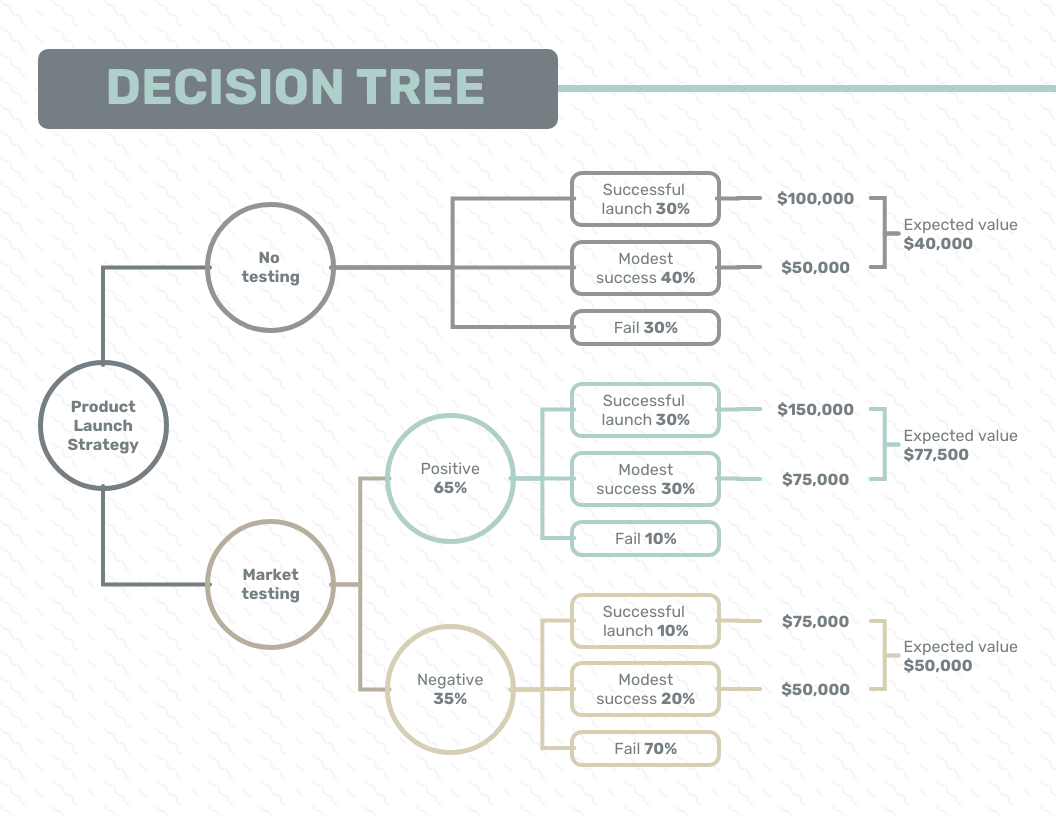The purpose of a decision tree analysis is to show how various alternatives can create different possible solutions to solve problems. A decision tree, in contrast to traditional problem-solving methods, gives a “visual” means of recognizing uncertain outcomes that could result from certain choices or decisions.
For those who have never worked with decision trees before, this article will explain how they function and it will also provide some examples to illustrate the ideas. To save you time, use Venngage’s Decision Tree Maker or browse our gallery of decision tree templates to help you get started.
Click to jump ahead:
- What is a decision tree analysis?
- What is the importance of decision tree analysis?
- 4 Decision tree analysis examples
- 5 steps to create a decision node analysis
- When do you use or apply a decision tree analysis?
- How to create a decision node diagram with Venngage
- FAQs on decision tree analysis
What is a decision tree analysis?
A decision tree is a diagram that depicts the many options for solving an issue. Given particular criteria, decision trees usually provide the best beneficial option, or a combination of alternatives, for many cases. By employing easy-to-understand axes and graphics, a decision tree makes difficult situations more manageable. An event, action, decision, or attribute linked with the problem under investigation is represented by each box or node.
For risk assessment, asset values, manufacturing costs, marketing strategies, investment plans, failure mode effects analyses (FMEA), and scenario-building, a decision tree is used in business planning. Data from a decision tree can also build predictive models.
There are four basic forms of decision tree analysis, each with its own set of benefits and scenarios for which it is most useful. These subtypes include decision under certainty, decision under risk, decision-making, and decision under uncertainty. In terms of how they are addressed and applied to diverse situations, each type has its unique impact.
What is the importance of decision tree analysis?
Business owners and other decision-makers can use a decision tree to help them consider their alternatives and the potential repercussions of each one. The examination of a decision tree can be used to:
- Determine the level of risk that each option entails. Before making a final decision, you can see how changing one component impacts others, so you can identify where more research or information is needed. Data from decision trees can also be utilized to build predictive models or to analyze an expected value.
- Demonstrate how particular acts or occurrences may unfold in the context of other events. It’s easy to see how different decisions and possible outcomes interact when you’re looking at decision trees.
- Concentrate your efforts. The most effective ways for reaching the desired and final outcome are shown in decision trees. They can be utilized in a multitude of industries, including goal setting, project management, manufacturing, marketing, and more.
Advantages of using a tree diagram as a decision-making tool
Decision tree analysis can be used to make complex decisions easier. They explain how changing one factor impacts the other and how it affects other factors by simplifying concepts. A summary of data can also be included in a decision tree as a reference or as part of a report. They show which methods are most effective in reaching the outcome, but they don’t say what those strategies should be.
Even if new information arises later that contradicts previous assumptions and hypotheses, decision-makers may find it difficult to change their minds once they have made and implemented an initial choice. Decision-makers can use decision-making tools like tree analysis to experiment with different options before reaching a final decision; this can help them gain expertise in making difficult decisions.
When presented with a well-reasoned argument based on facts rather than simply articulating their own opinion, decision-makers may find it easier to persuade others of their preferred solution. A decision tree is very useful when there is any uncertainty regarding which course of action will be most advantageous or when prior data is inadequate or partial.
Before implementing possible solutions, a decision tree analysis can assist business owners and other decision-makers in considering the potential ramifications of different solutions.
Disadvantages of using a tree diagram as a decision-making tool
Rather than displaying real outcomes, decision trees only show patterns connected with decisions. Because decision trees don’t provide information on aspects like implementation, timeliness, and prices, more research may be needed to figure out if a particular plan is viable.
This type of model does not provide insight into why certain events are likely while others are not, but it can be used to develop prediction models that illustrate the chance of an event occurring in certain situations.
4 Decision tree analysis examples
Many businesses employ decision tree analysis to establish an effective business, marketing, and advertising strategies. Based on the probable consequences of each given course of action, decision trees assist marketers to evaluate which of their target audiences may respond most favorably to different sorts of advertisements or campaigns.
A decision tree example is that a marketer might wonder which style of advertising strategy will yield the best results. The decision tree analysis would assist them in determining the best way to create an ad campaign, whether print or online, considering how each option could affect sales in specific markets, and then deciding which option would deliver the best results while staying within their budget.
Another decision tree diagram example is when a corporation that wishes to grow sales might start by determining their course of action, which includes the many marketing methods that they can use to create leads. Before making a decision, they may use a decision tree analysis to explore each alternative and assess the probable repercussions.
If a company chooses TV ads as their proposed solution, decision tree analysis might help them figure out what aspects of their TV adverts (e.g. tone of voice and visual style) make consumers more inclined to buy, so they can better target new customers or get more out of their advertising dollars.
Related: 15+ Decision Tree Infographics to Visualize Problems and Make Better Decisions
5 steps to create a decision node analysis
This style of problem-solving helps people make better decisions by allowing them to better comprehend what they’re entering into before they commit too much money or resources. The five-step decision tree analysis procedure is as follows:
1. Determine your options
Which can help deal with an issue or answer a question. A problem to be addressed, a goal to be achieved, and additional criteria that will influence the outcome are all required for decision tree analysis to be successful, especially when there are multiple options for resolving a problem or a topic.
2. Examine the most effective course of action
Taking into account the potential rewards as well as the risks and expenses that each alternative may entail. If you’re starting a new firm, for example, you’ll need to decide what kind of business model or service to offer, how many employees to hire, where to situate your company, and so on.
3. Determine how a specific course will affect your company’s long-term success.
Depending on the data being studied, several criteria are defined for decision tree analysis. For instance, by comparing the cost of a drug or therapy to the effects of other potential therapies, decision tree analysis can be used to determine how effective a drug or treatment will be. When making decisions, a decision tree analysis can also assist in prioritizing the expected values of various factors.
4. Use each alternative course of action to examine multiple possible outcomes
This way you can decide which decision you believe is the best and what criteria it meets (the “branches” of your decision tree). Concentrate on determining which solutions are most likely to bring you closer to attaining your goal of resolving your problem while still meeting any of the earlier specified important requirements or additional considerations.
5. To evaluate which choice will be most effective
Compare the potential outcomes of each branch. Implement and track the effects of decision tree analysis to ensure that you appropriately assess the benefits and drawbacks of several options so that you can concentrate on the ones that offer the best return on investment while minimizing the risks and drawbacks.
When do you use or apply a decision tree analysis?
A decision tree diagram employs symbols to represent the problem’s events, actions, decisions, or qualities. Given particular criteria, decision trees usually provide the best beneficial option, or a combination of alternatives, for many cases.
By employing easy-to-understand axes and drawings, as well as breaking down the critical components involved with each choice or course of action, decision trees help make difficult situations more manageable. This type of analysis seeks to help you make better decisions about your business operations by identifying potential risks and expected consequences.
In this case, the tree can be seen as a metaphor for problem-solving: it has numerous roots that descend into diverse soil types and reflect one’s varied options or courses of action, while each branch represents the possible and uncertain outcomes. The act of creating a “tree” based on specified criteria or initial possible solutions has to be implemented.
You may start with a query like, “What is the best approach for my company to grow sales?” After that, you’d make a list of feasible actions to take, as well as the probable results of each one. The goal of a decision tree analysis is to help you understand the potential repercussions of your decisions before you make them so that you have the best chance of making a good decision.
Regardless of the level of risk involved, decision tree analysis can be a beneficial tool for both people and groups who want to make educated decisions.
How to create a decision node diagram with Venngage
Venngage has built-in templates that are already arranged according to various data kinds, which can assist in swiftly building decision nodes and decision branches. Here’s how to create one with Venngage:
1. Sign up for a free account here.
2. From Home or your dashboard, click on Templates.
3. There are hundreds of templates to pick from, but Venngage’s built-in Search engine makes it simple to find what you’re looking for.

4. Once you have chosen the template that’s best for you, click Create to begin editing.

5. Venngage allows you to download your project as a PNG, PNG HD, PDF or PowerPoint with a Business plan.

Venngage also has a business feature called My Brand Kit that enables you to add your company’s logo, color palette, and fonts to all your designs with a single click.
For example, you can make the previous decision tree analysis template reflect your brand design by uploading your brand logo, fonts, and color palette using Venngage’s branding feature.
Not only are Venngage templates free to use and professionally designed, but they are also tailored for various use cases and industries to fit your exact needs and requirements.

A business account also includes the real-time collaboration feature, so you can invite members of your team to work simultaneously on a project.
Venngage allows you to share your decision tree online as well as download it as a PNG or PDF file. That way, your design will always be presentation-ready.
FAQs on decision tree analysis
How important is a decision tree in management?
Project managers can utilize decision tree analysis to produce successful solutions, making it a key element of their success process. They can use a decision tree to think about how each decision will affect the company as a whole and make sure that all factors are taken into account before making a decision.
This decision tree can assist you in making smarter investments as well as identifying any dangers or negative outcomes that may arise as a result of certain choices. You will have more information on what works best if you explore all potential outcomes so that you can make better decisions in the future.
What is a decision tree in system analysis?
For studying several systems that work together, a decision tree is useful. You can use decision tree analysis to see how each portion of a system interacts with the others, which can help you solve any flaws or restrictions in the system.
Create a professional decision tree with Venngage
Simply defined, a decision tree analysis is a visual representation of the alternative solutions and expected outcomes you have while making a decision. It can help you quickly see all your potential outcomes and how each option might play out.
Venngage makes the process of creating a decision tree simple and offers a variety of templates to help you. It is the most user-friendly platform for building professional-looking decision trees and other data visualizations. Sign up for a free account and give it a shot right now. You might be amazed at how much easier it is to make judgments when you have all of your options in front of you.




























